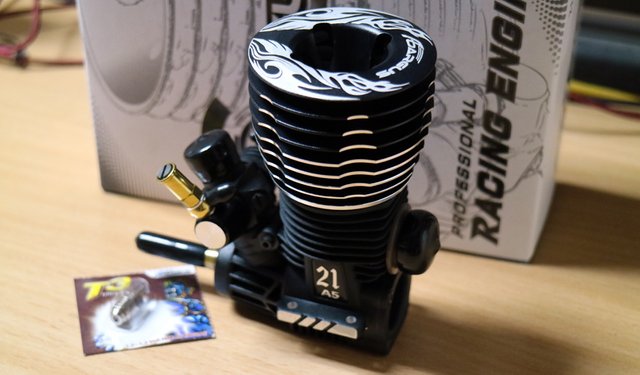
This is my second posts from a series that I'm starting about RC models, the first post was about the Basics of an Electric powered RC model cars and this one will cover Gas-powered models and what are the differences between electric and gas-powered RC model cars. I'll start with the basic explanation of what is a Radio Controller Car as well as what the differences are between toys and models like in the first post as this is really important to know...
What is a Radio-controlled car
Radio controlled (or R/C) cars are battery/gas-powered model cars or trucks that can be controlled from a distance using a specialized transmitter or remote. The term "R/C" has been used to mean both "remote controlled" and "radio controlled", where "remote controlled" includes vehicles that are connected to their controller by a wire, but common use of "R/C" today usually refers to vehicles controlled by a radio-frequency link. - Wikipedia
Essentially a radio controlled car consists of two things, the car itself containing everything it needs to run as directed by the user as well as a radio transmitter or a remote controller that is used to give commands to the car. Depending on the radio receiver inside the car and the radio transmitter used you can get from a few meters to hundreds of meters operational range for control of the RC vehicle.
What is the difference between a model car and a toy
People that are not into RC models can often mistake RC toys with RC models or think that they are essentially the same things - toys for kids, but that is not true. There are a couple of difference that make RC models suitable for all ages and there are models so advanced that nobody will even dare to call them toys. So what are the main differences between the two? Well, toys are toys, they are cheap plastic models with very limited and basic Remote control functionality and without the ability to replace broken parts with spares or install upgrades.
RC model cars are much more complex than a toy, they are built from many different parts that are available as spare parts and can be purchased and replaced if you break them, and there are also upgrades and tuning parts available. RC model cars come with more complex electronics that offers precise control and maneuvering capabilities and faster speeds in general. There are many different sizes and categories of RC model cars available, depending on the type of use and capabilities you expect - casual and racing models, on-road and off-road, electric-powered and gas-powered and so on. As a result of course RC model cars are more expensive than a toy car, but they also offer much more than just a toy RC car.
One very important thing regarding gas-powered RC model cars is that there simply no toys in this category... you cannot have a toy gas-powered RC model simply because it is going to be significantly more expensive to make than what you can do in the form of an electric powered toy car. Having an actual engine that needs liquid fuel in order to function makes these harder be used by smaller kids who are usually the target of RC toys.
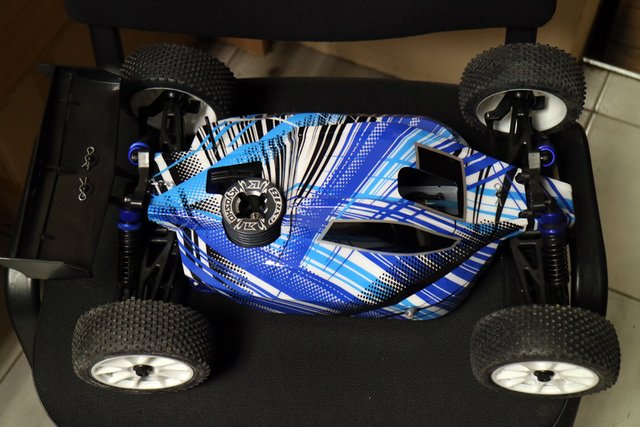
Electric vs Fuel-Powered RC Cars
With electric RC model cars things are a bit simpler in design and easier to maintain, but with gas-powered models the design is a bit more complex and demanding. It is more complex to maintain and tune and is generally messier because of the way engines work. Actually the terms gas-powered may be a bit misleading as most smaller scale RC model cars actually do not use gas as fuel, but instead use a special nitro methane fuel mixed with oil so they should be called nitro-powered and not gas-powered. Only the large 1:5 scale car models actually run on gas, so they can be called gas-powered, though they use different engines when compared to the smaller and more common 1:10 and 1:8 scale models.
Besides the fact that there are no gas-powered or nitro-powered toy models as already mentioned, there are also not very small scale RC model cars that use anything other than electric motor. With electric motors you can get really small, but with real engines that need to burn fuel this is not an option and you cannot go very small. The smallest scale you can get a nitro-powered RC car is probably at around 1:16 as otherwise there will just be not enough space for the engine, the fuel tank and the other components required to make such a car run.
Do note that even though I'm actually talking about gas-powered and nitro-powered RC models they still do need to use batteries and electronics to make them operate. You still have servo machines for the steering and for controlling the throttle and brakes as well as to power the receiver that gets the commands from the transmitter or remote control that the driver holds and uses to operate the RC car. You can however do with a smaller battery as it is not required for the engine operation, only for some support work as the fuel is actually providing the driving force.
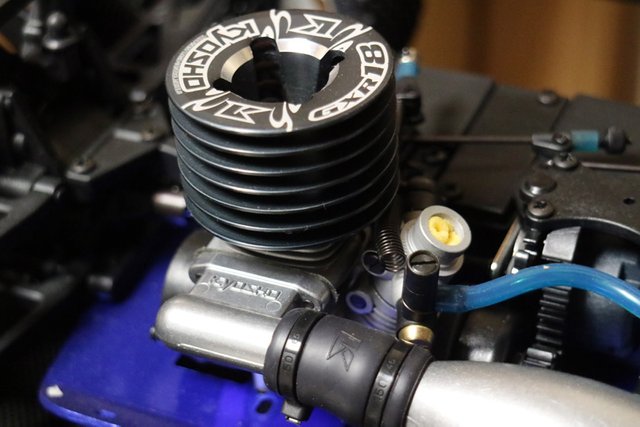
The Engine is Really Important
The key component of an RC model car using an engine instead of an electric motor is the engine itself obviously. The smaller scale RC models use the so called Glow Engines powered with nitro fuel while the larger 1:5 scale use Gas engines that are apparently using gas as fuel. The engines are real internal combustion ones and the smaller ones run on special more potent fuel as their compact size still needs to provide a lot of power to drive the RC model that usually weights from about a kilogram to a few kilos.
Glow engines for RC models need a glow plug to ignite the fuel and make the engine run, this plug needs to be heated with the help of a battery, but it does need external energy after you start the engine, you would again need to apply electricity to the glow plug only in case the engine stops and you need to restart it. Apart from powering the glow plug with electricity you need to also give the motor initial rotation so the fuel can actually enter the combustion chamber, ignite and thus provide enough power for the motor to continue operating as long as there is fuel coming in. This initial start is either provided by hand by pulling a so called pull starter or by using an electric operated starter box, again only required to start up the engine.
The engines used in RC model cars are carburetor-based for providing the fuel to the engine. This is essentially what provides the engine with the required fuel and air needed for engine maintaining the combustion inside. The carburetor needs to be fine-tuned by the user for optimal operation and that tuning may be required again after a while of use, or if you change he fuel you are using, or if the conditions you are driving the RC models change significantly. The carburetor usually has two or three needs that are being rotated to adjust the mixture of fuel and air that is being fed to the engine. The settings needed to be adjusted here can vary from model to model and from engine to engine, so you will have to read the manual to get more details on which needle to adjust for what. Adjusting these settings is pretty much the most annoying thing for many people as sometimes it can take quite a lot of time to get it tweaked and you need to do it before you can start fun driving the RC model. If not properly tuned the engine may stop or not run optimally and that can easily ruing your fun, but as you get to learn and play around with the engine a bit you should get better and be able to tune it faster.
Because of the combustion of fuel happening inside the engine it obviously heats up and needs to be cooled down with the help of the cold air passing through the special head of the engine. While in operation the engine is normally running at over 100 degrees Celsius and can easily reach up to 150-160 degrees or more under heavier load, you should consult your engine's manual for the optimal operating temperatures. It is not advised to try to run the model at high speed immediately after you start the engine before it heats up to at least 70-80 degrees for example and it is not wise to reach too high temperatures and overheat the engine as you might damage or even completely destroy it.
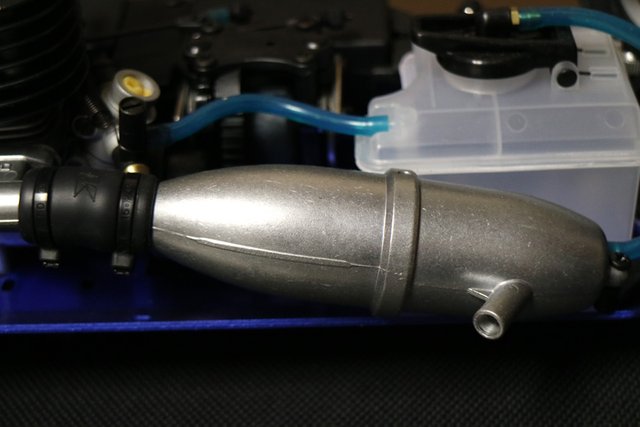
Other Requirements Besides the Engine
Just like with any other internal combustion engine you would need to have a fuel reservoir that holds the fuel you use and as you run the RC model you will need to refuel it and there is also the exhaust system that needs to lead out the exhaust gases from the engine after the combustion of the fuel. With RC model cars this exhaust system is called a tuned pipe and it reduces the noise coming from the engine and moves away the exhaust gases. There are also some fuel lines that are connecting the different components of the engine, these are silicone tubes made to be resistant to the fuel and also to high temperature.
Depending on the scale of the car, its type, fuel and engine used, the capacity of the fuel tank may be different in terms of capacity it can hold. Normally the fuel should last for at least about 6-8 minutes in a demanding driving such as when racing at high speeds and not doing slow speeds. Normal driving for fun with slow and high speeds should provide you with more running time like 12-15 minutes or even more, before having to add more fuel in the fuel tank. Only the larger 1:5 scale models usually come with larger fuel tanks that can hold enough for something like 30 minutes of driving or even more.
The exhaust system or tuned pipe also has its role and that goes not only for it being an essential part for the normal operation of the engine. The tuned pipe can affect the operation of the engine. Often cheaper glow engines do come with a pipe that is ideally suited for them that does not allow a lot of further adjustments, but if you move to a higher-end engine you can also find custom pipes for it as well that may allow further tuning of the operation of the exhaust system and thus affecting how the motor operates.
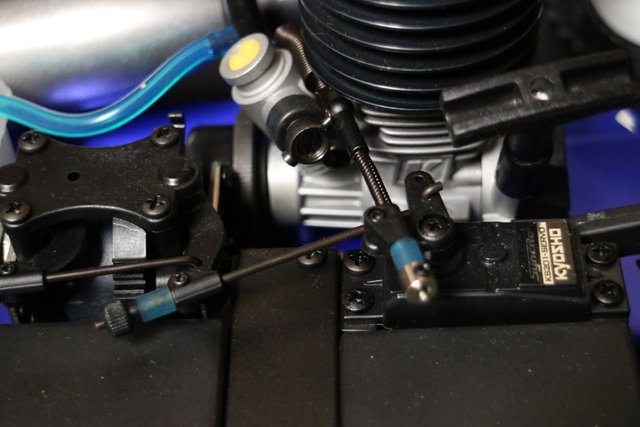
Additional Servo Required
If you remember in the previous post about the Electric powered RC model cars you needed just 1 servo for the steering (some larger models may actually use two servos) of the car, but with fuel-powered models you actually need a second servo for controlling the brake and throttle of the model. On electric vehicles the ESC is doing all of the control by giving commands to the motor to go faster or slower or to brake, but with fuel-powered cars you need a servo to mechanically control the speed of the engine. The same servo, when driven in the opposite direction, usually is being used to control the mechanical braking of the fuel powered models. Brakes on electric cars happen when you short the motor and it stops rotating, but with fuel-powered models you need to use brake discs similar to the ones used by regular big cars for stopping the model. Unlike normal cars however where you get brake disks on two or four wheels of the car with fuel-powered models the brake is not applied on the wheels, but on the driveshaft that makes the wheels moving.
Unlike electric RC model cars where you can easily drive backwards as all you need to do is reverse the rotation of the electric motor, with fuel-powered cars this is not an easy thing to do, so as a result most nitro and gas RC model cars do not feature the option to move in reverse. There are some models that have additional components that allow them to switch to backwards movement, but this makes things more complex as it requires additional control channel and mechanical as well as electric components. So don't go looking for reverse option on these models and be careful when driving to that you will not need to go in reverse or you will most likely have to go to the car and move it manually to be able to continue driving it.
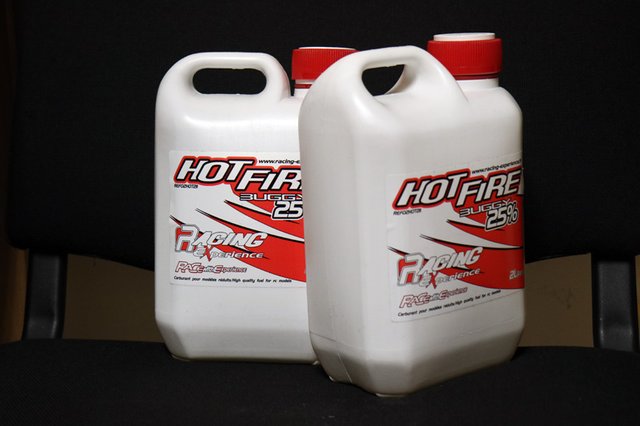
The Nitro Fuel or Gas
The fuel used together with your fuel-powered RC model car is very important, just like with the battery you need to power an electric RC model. As I already mentioned there are generally two types of fuel used for RC models: regular gas for the larger 1:5 scale models (mixed with more oil) as well as special nitro methane based fuel mixed with oil that is designed for the smaller scale 1:8, 1:10 and smaller models. You should not try to run a nitro model with gas fuel and the opposite as it will not work and may as well as result in damaging something and costing you to repair or replace it. With larger 1:5 scale models you can just go to the fuel station and get the fuel that you need for the model as well as your regular car (don't go for diesel as it will not work). You may have to add some more motor oil inside, there are some recommendations that you need to follow to get the optimal mixture, though I'm not going to be getting into details about that now.
With nitro fuel for the smaller scale models you cannot just get fuel the same way, you normally have to buy it ready for use, though you can still buy the components and mix it yourself if you know what to do. These fuels consist of methanol, nitro methane and ricin oil or synthetic oils (other additives can also be present). The oil inside the fuel is needed to lubricate the moving parts inside the motor so it is very important component. If the oil is not doing its job well your engine may overheat or get damaged from the friction between the metal parts inside, so mixing fuel yourself is not the best thing to do unless you really know what to do. Nitro methane fuel is generally more expensive than gas, though the RC models don't use that much fuel as a larger car.
Methanol is usually the main component of the nitro fuels, this is the part of the fuel that burns. The nitro methane is actually used as a catalyst to give more power to the fuel, so the more nitro methane the more powerful it is allowing the motor to run faster. You should be careful though as the higher the nitro methane contents, the hotter the motor can get, so you need to make sure to use the kind of fuel that works best with your motor. The nitro fuels usually come with a percentage written on their bottles or tubes, that percentage represents the amount of nitro methane that is available inside the fuel mixture. Common numbers are 16%, 20% and 25%, though there are fuels with more or less nitro methane available in them as well. Going for a 25% percent one is usually what is used in RC car races, while for normal operation 16% or 20% are preferred. The reason for that is during a race you actually need more power than when driving for fun in the park for example and when driving for fun you probably would not want to overheat your engine pushing it to its limits like you may want to do in a race.
If you have a question or want to add something, then please leave a comment below.
Did you like what you have just read? Check my other posts on steemit @cryptos